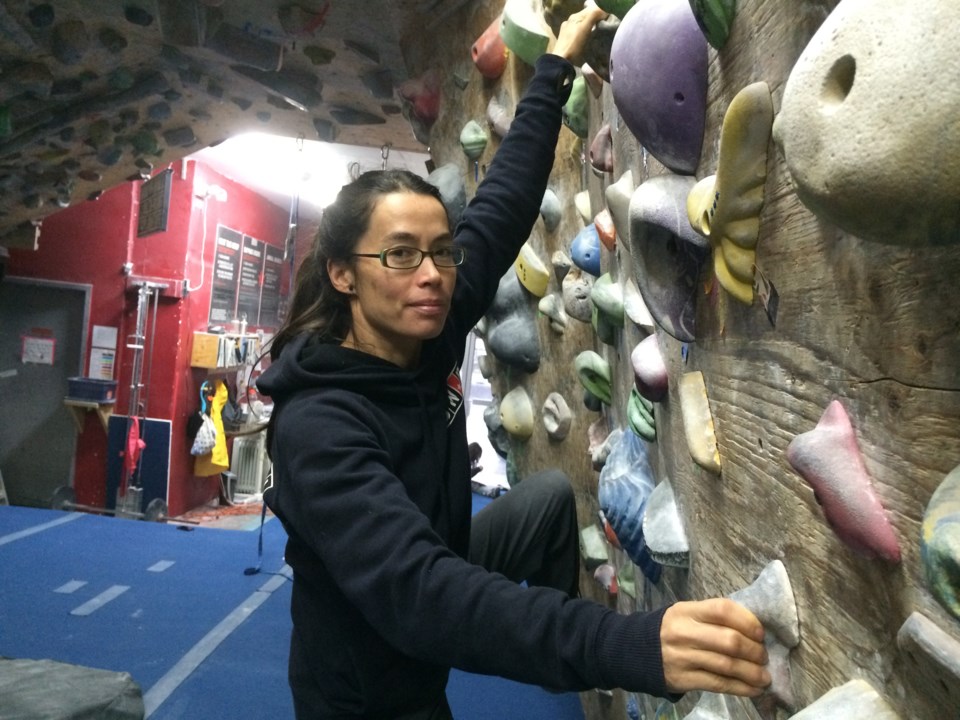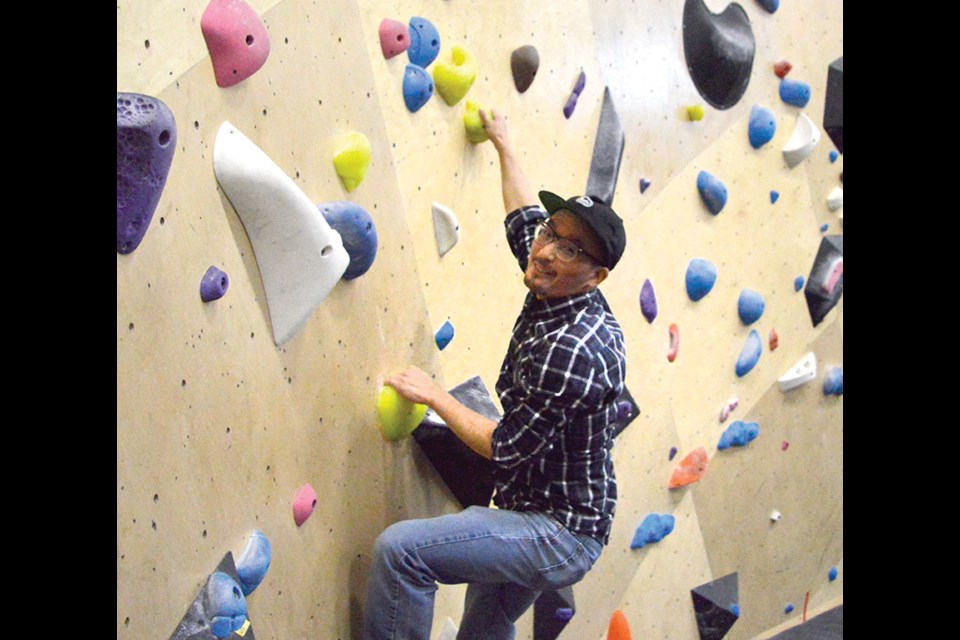Climbing shoes on. Harness on. Is the knot a double figure-eight? Are the carabiner and belay device fastened to the red strap?
I’m watching Lauren Watson, the owner of Ground Up Climbing Centre, strap my fellow reporter Jennifer Thuncher in for her first climb — indoor or outdoor.
Watson starts belaying Thuncher, who hesitates for a few moments. But after a little bit of coaxing, Thuncher starts to ascend one of the walls at Ground Up.
She grabs each hold with a slight hesitation — as if each of the rough-edged plastics might betray her. After a few moments, she makes it up a few feet.
As I look at my friend reach for the gym’s climbing holds for the first time, an old memory begins to surface.
It is a really old one — one of my first.
I couldn’t have been more than three years old at the time. In it, I’m on top of the little stoop of an aging bungalow.
I’m with a handful of friends, and everyone takes turns jumping down from the four-step flight leading up to the door.
I’m the last one still on top. To me, it looks like I’m staring down from the peak of Mount Everest. I lean forward, then back. I look at the ground for a long time. My friends — and even some parents — encourage me to take the jump, but I refuse to go down.
A lot of time passes — enough that everyone’s moved on to do other things. Eventually, I go down and instead jump from the third step.
This would be the first time I realized I had a fear of heights, as well as the first time I tried to do something to confront that worry.
There was some gratification in that experience, but for the most part, I found it to be stressful. Save for a handful of exceptions, I wouldn’t feel the desire to revisit the feeling for a long, long time.
However, moving to Squamish changed that.
Initially, I had no desire to get involved in the town’s climbing scene, but over time my curiosity would eventually lead me to the base of the Stawamus Chief, where I saw one climber ascend a rock the size of a small house.
“Hey, it’s not too bad — unless you’re afraid of heights!” he called down.
Well, that qualifier applied to the person looking up from below, and it bothered me. I had to learn how to beat it, and it’d later be a question I’d ask Watson at the gym.
When I queried her about it, Watson explained to me that one of the best ways to combat fear was with safety skills.
“It’s a process of rationalizing,” said Watson. “Allow yourself to get into that zone where you’ve checked all the safety and you’ve checked all the systems, and you’re in a rational place where you can start pushing your body.”
For example, bouldering — that is, climbing up boulders without a rope — becomes more manageable when you know how to fall.
But it doesn’t stop with being knowledgeable about safety procedures. Developing skill is another aspect to beating fear.
That’s when Watson also told me about the holy trinity of climbing.
All sports require physical conditioning, technique, and mental strength in different proportions, she said.
Climbing, however, generally requires a balance of all three, which all feed into each other, Watson said.
It’s hard to have mental toughness if you know you’re too tired to grasp that hold. But perhaps you’d be able to make that move with a technique that would reduce the amount of energy needed.
As a starting point, Watson said it’s a good idea for beginners to isolate each aspect of climbing, work on that alone, then move on to another skillset.
“You’re just working on the ground level on vertical walls the simple basics of footwork and hand positioning,” she said, describing a beginner’s training routine.
That advice made me consider putting more time into bouldering.
Because bouldering takes place much lower to the ground than rope climbing, I reasoned it’d be a good starting point for focusing on technique. I’d start from the bottom, literally.

So one rainy afternoon, I found myself at the door of Grand Wall Bouldering Co-op.
It was there I met Thomasina Pidgeon, a member of the board of directors at this non-profit facility.
Pidgeon told me one of the best ways to get started is by moving laterally across the space while focusing on putting my weight on my feet.
“Go on that back wall and practice just moving across the wall,” she said. “Practice your footwork, try to step really quietly on the footholds.”
While being the world’s quietest climber isn’t the goal, quiet climbing is an indicator that your body weight is being distributed efficiently.
For instance, whenever your feet slip or get snagged in a bad place, it’s often a noisy affair.
There are a number of times I slipped and tumbled and fell, but Pidgeon said bouldering can be great for beginners because the recovery time from a fall can be shorter.
I ended up picking myself up off the floor more times than I’d hoped would be necessary.
Half of it was from a lack of strength, but if I was honest, a lot of it was a tendency to jump down when I’d felt I’d gone up a little too high up for my comfort.
It’s like my nervous system hit the eject button.
Over time, as the weeks passed, I kept chipping away at it. It’s a funny sight — watching a grown man fail at routes that 12-year-olds seem to breeze through with ease.
It was humbling, but over time I began to realize that at the very least, there was one benefit.
In a strange, counterintuitive way, I began to realize the fear I get when I’m on the wall becomes something that relaxes, rather than stresses me out.
I noticed I’d be ending my climbing sessions feeling calm in a way that I didn’t get from other sports.
The thing is this — when you’re high up, crimping a tiny hold for dear life, it’s impossible to think about anything else.
The day-to-day worries that rust away at our minds seem to disintegrate in those moments when it feels as if you’re in real, immediate danger.
I’ve had arguments in my head while on a treadmill, but never while clutching at the polyurethane shards lining Ground Up or Grand Wall.
All the unpaid bills, interpersonal squabbles, and self-narrated dramas — those voices get quieter the higher you climb.
Later, I stumbled onto one more benefit.
That day, I was on the bouldering wall and I’d just reached the final hold of my route.
After I grasped it with both hands, I realized I was too burned out to climb downwards.
I stared at the floor and my breath escaped me for a second.
It felt like I was three again, standing on top of the stoop of that aging bungalow.
This was a height far greater than four steps.
This time I made the jump.
I’d begun to learn how to fall.



